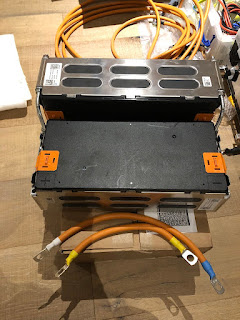The adapter plate drawing process
Now that I have 2 transmission bell housing, one on the car, and one in my kitchen, I can start. I'll be using the one in my kitchen to derive all the measure needed to accurately position the flange fitting holes.
Tracing
I've used a millimetric graph paper over which I've traced the shape and holes position of the bell housing.I've used an ultra thin pen to make sure the tracing was accurate.
Drawing
With all the sizes and dimensions taken, I could now move on to think about how to design a flange adapter plate that would fit the bell housing nicely.More quick drawing to think about how to shape the adapter plate and fit the motor and and the flywheel.
I thought that a circular shape could end up being more flexible and be adaptable to more models of cars if I wanted to extend this experiment to work on other cars too. It can be also cheaper to machine on a lathe or a CNC machine.
3D Modeling
The idea to base the plate on a circular shape was reinforced by spotting a circular pattern with the distribution of the holes in the bell housing.
I started to play around with Fusion 360 a 3D design software to model my adapter plate.
On one side this plate features the holes to mate to the transmission bell housing and the other side to hold the Motor in place.
The adapter plate will house the flywheel with the clutch.
For the Flywheel I had a few options:
- to get a second hand flywheel which would cost around 80-100 GBP and modifying it. – I would not use flywheel that comes with the engine as I want to keep intact and demonstrate how easily the vehicle can be turned back to be an ICE and do the engine-motor swap a few times in the future.
- Or design one and then machine it or get machined.
The making – CNC or Lathe Machining
To get these parts made I could have done them myself on the lathe at the rLab the Hackspace here in my town. Or get them done.
Looking at how much a block of aluminum would cost I couldn't find anything cheaper than 200 GBP and that was just close to the size I needed.
So I went out to ask for quotes to the likes of Protolabs, Get-it-made, ABC Custom, Geomiq, HLHProto, Factory to get it done for me.
All you have to do is basically to upload your 3d file, select material, finish and a few other parameters.
When my quotes came back these were between 350 and 600 GBP for the adapter plate, the flywheel was half of that.
Considering the efforts of doing it myself and the costs of getting it done in the end I've opted to get it done.
After a couple of weeks the Adapter Plate and the Flywheel were delivered.
For the records, the adapter plate is aluminium anodised and dyed in blue. The flywheel is aluminium without any treatment.












Comments
Post a Comment